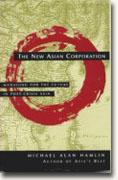New Asian Corporation
Michael Alan Hamlin
book reviews:
· general fiction
· chick lit/romance
· sci-fi/fantasy
· graphic novels
· nonfiction
· audio books
· author interviews
· children's books @
curledupkids.com
· DVD reviews @
curledupdvd.com
newsletter
win books
buy online
links
home
for authors
& publishers
for reviewers


|
New Asian Corporation: Managing for the Future in Post-Crisis Asia Michael Alan Hamlin Jossey-Bass Hardcover 286 pages 2001  |
|
Western critics waggled their fingers at “Asian Values”, defined loosely as overinvesting in unproductive sectors like real estate, crony capitalism, family-dominated corporations with murky balance sheets, kleptocratic political leaders who protected investors in exchange for lucrative favors to family members, and the psychological effects of cultures based on rigidity, hierarchy, denial, and consensus. During that same year many Asian political leaders waggled their fingers back, pointing to the World Bank’s inept financial prescriptions, rampant globalization, greedy financiers, too much investment in too little diversity, the West’s loose morals, and, in one political leader’s view, a cabal of Jewish financiers from New York. For a year this went on, even as a handful of political leaders and business investors tried to settle the differences and fix things. Little noticed outside of professional management circles was a book entitled Asia's Best: The Myth & Reality of Asia's Most Successful Corporations by Michael Alan Hamlin. However, inside management circles it created waves. It was the first book to go beyond American and Japanese models of successful companies to look at less-noticed regional businesses. His book shattered the myths about Asian’s "opaque" management ways and showed how certain Asia's best companies could stand up there with the world's best. His examples came from off-the-beaten-track locales: In his home-base country of the Philippines, he analyzed, among others, the Jollibee fast-food chain, Eastern Telecommunications Philippines, Inc., Manila Electric Company, Megalink Inc., National Steel Corporation, Petron Corporation, Philippine Appliance Corporation, San Miguel Corporation, and Philippine Business for Social Progress. Hamlin dissected the common myths about Asian business and found the following: (a) Asia did not have a unique Asian management style suitable only for Asia; (b) that Asian companies tended to acquire technology by buying it rather than developing it through joint venture agreements or alliances; (c) innovation among Asian companies was awful and, "Basic research throughout Asia, despite rapid, sustained growth over two decades is virtually nonexistent"; and (d) successful Asian companies are "masters of nichemanship" rather than "sprawling conglomerates." Given the economic collapse Southeast Asia was experiencing, his conclusion was a bitter pill: "While productivity in Asia has been rising, very little purely Asian technology has accounted for the increase. As the region enters a new era of liberalization and intense competition, its reliance on Western technology and low value-added exports is dangerously high. Worse, not enough investment has been made in education and the development of research centers necessary to support the creation of indigenous, productivity-enhancing technology. Massive public and private investment in educational infrastructure will be required to sustain rapid growth in Southeast Asia." Mr. Hamlin was not alone in the gloom department, but his assessment was dramatically different than that of the alpha-males of the guru pack Michael E. Porter, Gary Hamel, and C.K. Prahalad. They interpreted Asia’s problems in terms of poor use of resource availability (including labor), and opportunity. Mr. Hamlin, much closer to the action, interpreted Asia’s problems in terms of enhancing resourcefulness and focusing on profitability growth rather than market share growth. During 1998 and 1999 the business press and economists as notable as Paul Krugman stated that unless Asia changed its business and political thinking in fundamental ways, the then-extant recovery would go belly-up the moment the next crisis came along. When it did, triggered by the burst of the dot.com bubble and sectorial recession in the USA, Asian producers yet again found themselves facing hard times. This time they were really hard: Singapore, that bastion of meritocracy and meticulous government planning, found it had built far too many “fab-lab” computer chip makers and far too little of the diversified electronics manufacturer that Taiwan was so good at. Japan dithered over its massive real-estate debt and flaky banking system (and is still doing so). Thailand’s top cronies talked a great story but didn’t make the substantive changes needed to charm ever-fussier investors. Malaysia spent vast amounts of the public retirement fund to richly award a handful of politically anointed favorite sons who also happened to be lousy businessmen. During this same period Mr. Hamlin was analyzing events with the same astuteness he used in his “Asia’s Best” book. He distilled his latest thinking in The New Asian Corporation. What did he come with? Mr. Hamlin makes a fairly good case that a “New Asian Corporation” has emerged as the positive side of the two economic crises that have hit the region. He cites three fundamental changes in Asian social and business thinking that make this possible:
Asia is “Rising From the Ashes,” as Mr. Hamlin puts it, because eleven behavioral patterns have irrevocably changed:
© 2002 by Dana De Zoysa for Curled Up With a Good Book |
|
|
|
 Click here to learn more about this month's sponsor! |
|
| fiction · sf/f · comic books · nonfiction · audio newsletter · free book contest · buy books online review index · links · · authors & publishers reviewers |
|
| site by ELBO Computing Resources, Inc. | |
 How easy the pedestal broke, how messy the pieces became. The straw that broke the camel’s back was an obscure stock trading opportunity in Thailand, whose unintended consequence was to blow down the entire Asian house of economic cards.
How easy the pedestal broke, how messy the pieces became. The straw that broke the camel’s back was an obscure stock trading opportunity in Thailand, whose unintended consequence was to blow down the entire Asian house of economic cards.